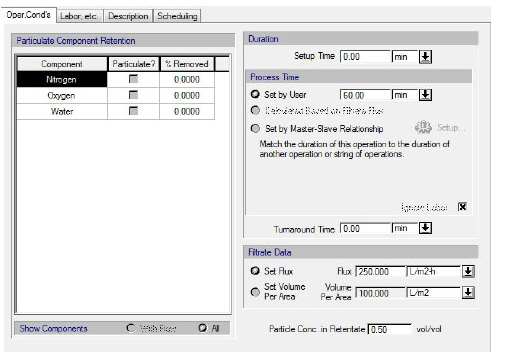

The following table shows a brief description of the variables appearing in this tab. The table also displays their default values and their generally acceptable range:
|
Variable |
Default Value |
Range |
|
|
||
|
○ % Removed |
0.0 |
0-100 |
|
○ Particle Conc. in Retentate (vol/vol) |
0.5 |
Positive |
|
○ Setup Time |
0.0 |
Positive |
|
◙ Process Time (min) |
60.0 |
Positive |
|
○ Ignore Labor? |
Yes |
Yes/No |
|
○ Turnaround Time |
0.0 |
Positive |
|
◙ Filtrate Flux (L/m2-h) |
250.0 |
Positive |
|
◙ Filtrate Volume Per Area (L/m2) |
100.0 |
Positive |
Symbol Key: ○ User-specified value (always input); ● Calculated value (always output); ◙ Sometimes input, sometimes output
The following list describes the available specification choices in this tab; for more details on how these are implemented, see Dead End Filtration: Modeling Calculations.
•Filtration Time Options...
a) You can set the process time (Filtration Time)
b) You can have the process time calculated based on the average filtrate flux. (This option is available only in rating mode)
c) You can match the duration of this operation to the duration of another operation by introducing a master-slave relationship between the two operations. The program will match the setup-time, the process time and the turnaround time of this pumping operation (the ‘slave’) with the corresponding times of the reference operation (the ‘master’ operation). For more on master-slave relationship, see The Scheduling Tab.
•Removal of Particulate Components...
When the ‘Calculated’ option is selected, it is assumed that 100% of all components that have a particle size greater than the filter pore size is retained by the filter.
•Filtrate Data...
When the Process Operating Mode is Batch you can set either the Filtrate Flux or the Filtrate Volume Per Area. In all other cases, the Filtrate Volume Per Area is calculated by the program.